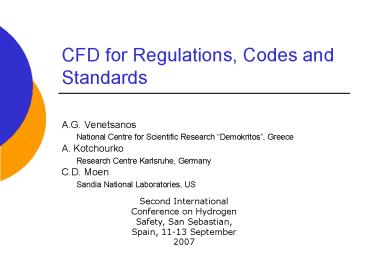CFD for Regulations, Codes and Standards PowerPoint PPT Presentation
1 / 12
Title: CFD for Regulations, Codes and Standards
1
CFD for Regulations, Codes and Standards
- A.G. Venetsanos
- National Centre for Scientific Research
Demokritos, Greece - A. Kotchourko
- Research Centre Karlsruhe, Germany
- C.D. Moen
- Sandia National Laboratories, US
2
Presentation Outline
- It will be shown that CFD is increasingly applied
to provide the necessary support to RCS
development - EIHP-2 project
- HyApproval project
- HyPer project
- It will be shown that CFD tools are increasingly
validated against H2 dispersion/combustion
phenomena - HySafe project
- ICHS-2 Session 1
- What we are going to see/listen
- Venetsanos et al. (ICHS-2, 2007)
- An Inter-Comparison Exercise On the Capabilities
of CFD Models to Predict the Short and Long Term
Distribution and Mixing of Hydrogen in a Garage
3
EIHP2 project CGH2 bus in a city
CFD applications
LFL clouds
Release of 40 kg H2 (168 kg CH4) through 4 outlet
vents at the top of the bus (Stockholm accident
site)
H2, 20MPa, 10.9s, 12.1 kg
CH4, 20MPa, 7.9s
Urban site (Stockholm) showing assumed bus
location
H2, 70MPa, 5.2s, 18.5 kg
H2, 35MPa, 7.7s, 14.7 kg
Bus storage system
Taken from Venetsanos et al. (2007) J. Loss
Prevention in the Process Industry, In Press
4
EIHP2 project CGH2 bus in tunnel
CFD applications
LFL clouds
Release of 40 kg H2 (168 kg CH4) through 4 outlet
vents at the top of the bus
CH4, 20MPa, 40s, 1756m3, 110kg
H2, 20MPa, 40s, 2358m3, 32.4kg
H2, 35MPa, 30s, 2180m3, 32.5kg
Taken from Venetsanos et al. (2007) J. Loss
Prevention in the Process Industry, In Press
5
HyApproval project Examined scenarios
CFD applications
Shell-HSL experimental site (2006)
- Dispenser rupture of dispensing line (CGH2 35
and 70 MPa, LH2) - Trailer Hose disconnection during discharge
(CGH2 20 MPa, LH2)
Luxemburg CGH2 site
Washington DC, LH2 site
Taken from HyApproval Deliverable 4.6, 2007
6
HyApproval project LH2 dispenser leak
CFD applications
267g LH2 released in 5 seconds (hose id 8mm)
Predicted LFL clouds at 5 sec
5 m/s wind at 10m height
South wind
North wind
Stagnant
West wind
East wind
Taken from HyApproval, NCSRD-JRC report, 2007
7
CFD applications
HYPER project Barrier wall design
- Jet flame experiments are used to validate CFD
methodology for jet flames from high-pressure
sources. - CFD calculations are used characterize
consequences of unintended releases. - Barrier walls are a potential mitigation strategy
for jet releases.
Fuego 3-D RANS simulation of H2 Jet Flame Wall
Impingement
Sandia/SRI H2 Jet Flame Wall Impingement Test
(2500 psi)
Taken from Houf et al., 2nd ICHS, 2007
8
Hyper project Fuel Cell Leak
CFD applications
Fuel cell located inside naturally ventilated
test facility
14.8g H2 released in 60 seconds
Naturally Ventilated Test Facility (CVE)
Location and Interior of Fuel Cell
9
HySafe project Dispersion CFD benchmarking
10
HySafe project Combustion CFD benchmarking
Main parameters important from the point of view
of safety analysis
11
Conclusions
- CFD is increasingly applied for H2 safety studies
and RCS support - Main reasons
- CFD has the ability to treat complex scenarios,
which simpler integral tools cannot handle - CFD cost is relatively lower than experiments
- CFD tools present generally realistic simulation
times - CFD tools/models are increasingly validated
against H2 dispersion/combustion phenomena
12
ICHS-2 Session-1 Contents
- CFD applications
- Analysis of naturally ventilated h2 from
buildings, Barley et al. - CFD simulations of h2 release and dispersion
inside the storage room of a HRS, Papanikolaou
and Venetsanos - Simulation of detonation after an accidental h2
release in enclosed envirnments, B?dard- Tremblay
et al. - CFD simulation study to investigate the risk from
h2 vehicles in tunnels, Hansen et al. - High pressure h2 jets in the presence of a
surface, Benard et al - CFD validation
- HYSAFE SBEP-V3 results, Venetsanos et al
- HYSAFE SBEP-V5 results, Jordan et al
- Validation of CFD calculations against ignited
impinging jet experiments, Middha et al. - Numerical study of spontaneous ignition of
pressurized h2 release into air, Xu et al. - CFD modelling of h2 dispersion experiments for
SAE J2578 test methods development, Tchouvelev et
al. - Experimental work
- Processes of the formation of large unconfined
clouds following a massive spillage of liquid
hydrogen on the ground, Proust et al. - Experimental study of jet-formed hydrogen-air
mixtures and pressure loads from their
deflagrations in low confined surroundings,
Friedrich et al. - Experimental and numerical investigation of h2
Gas Auto-Ignition, Golub et al - Unintended Releases of hydrogen, Houf et al

